More about Thimbles





Magdalena and William Isbister.
The Bateman silversmithing dynasty is arguably the most famous British dynasty of silversmiths ever to have been recorded. Hester Bateman was born Hester Neden or Needham in 1704 in Clerkenwell. Little is known about her childhood except that she was baptised in October 1708 and was not able to read or write. In about 1725 she married a gold chain and wire maker, John Bateman, who it seems never completed an apprenticeship and was thus not allowed to use his own mark. Hester had six children, John, Letitia, Ann, Peter, William and Jonathon before her husband died from Tuberculosis in 1760. They lived at 107 Bunhill Road in the Parish of St Luke in North London and subsequently bought adjoining properties for two of their children. Both Peter & Jonathan were apprentice silversmiths when John Bateman Sr. died. Despite this John senior is reputed to have left, in his will, unto his loving wife all his ‘household goods and implements" and this has been interpreted as indicating that Hester was already an accomplished silversmith although this has recently been challenged (1). Hester took over the family business and in 1761 was allowed to register her first mark, a scripted ‘HB’, at the age of 52, at the Goldsmith’s Hall in London. She was soon assisted by her two sons, Peter and Jonathan together with Jonathan’s wife Ann who was also a trained silversmith. Little is known of her early work, she may have been supplying other silversmiths who then over-stamped the item with their own mark. She was able to run and expand the family business during the next 30 years when, at 81 years of age, she retired. Shortly after her retirement Jonathan died and thus Peter and Ann were alone. Ann became the driving force until her retirement in 1805. William l, Anne’s son, and William ll her grandson also skilled silversmiths, joined the business and were producing some of the best silver pieces of the time but in spite of this the business gradually declined and by the middle of the 19th century the Bateman silversmithing dynasty was no more.
Hester Bateman’s work is highly regarded because of the quality of the design and the beautiful decoration. Hester's skills were in hammering, raising, planishing (‘give a smooth finish to by striking lightly with a smoothly faced hammer’), burnishing and engraving. All of the pieces that left the workshop would have been inspected to the highest standard. Hester was one of the first silversmiths to use steam to power machinery which enabled her to use thinner silver for her work and this, in turn, meant that her items were less expensive and thus accessible to many more people. The Bateman workshop produced a prolific quantity of items in the 18th century. Unlike many silversmiths of the time who specialised in a single area of production, the Batemans were producing fine wares including spoons, forks, serving utensils, dinner plates, goblets, salt cellars, mustard pots, wine labels, funnels and coolers, teapots, cream jugs, butter shells, tea caddies, trays, salvers, waiters, inkwells, important horse racing trophies and thimbles. They received many commissions from The City Guilds, various religious establishments, and private individuals. A Verger's Wand requested by St. Paul's Cathedral can still be seen in use in the Cathedral today.
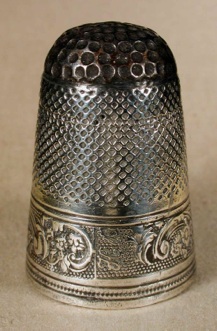
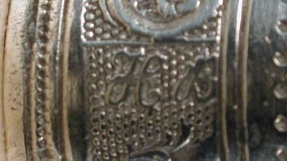
Steel topped silver thimble made by Hester Bateman with ‘HB’ mark
Between the 16th and 17th centuries ‘The Americas’ were opening up for trade. Many European countries were competing, the Spanish in the South West, The Russians in the North West, the English in the South East and the French, Dutch and English in the North East. Probably the most famous trading organisation resulting from the need to organise and compete was the Hudson’s Bay Company. It was established, and granted a monopoly to trade into all the rivers that flow into Hudson Bay. From 1670 onwards, the Hudson's Bay Company sent two or three ships into the Bay every year to bring back furs (mainly beaver) which were then sold for hat making in England. Some fine furs were sent to Holland and Germany.
The first Europeans to purchase furs from Indians were French and English fishermen who, during the 1500s, fished off the coast of North Eastern Canada and occasionally traded with the Indians (2). In exchange, the Indians received European blankets, guns, powder and lead, knives, kettles and pots, cloth, food and spices, whiskey. The early Spaniards in the South West (3) traded horses, sword blades for lances, wool blankets, horse gear, turquoise, and agricultural products, especially dried pumpkin, corn, and bread with the Indians. The trappers of the North East (4) traded items specifically brought out for trade including beads, brass rings and bracelets, Vermillion, bells, ribbons, and cloth which were highly sought after by the Native women. The English in the Southern Colonies (5) traded axe heads, knives, awls, fish hooks, cloth of various types and colour, woollen blankets, linen shirts, kettles, jewellery, glass beads, muskets, ammunition and powder.
Native Americans traded thimbles for decorating their clothes from Florida (6) to the Plains. Usually the thimbles were made of brass and all sorts of thimbles seem to have been traded. The thimbles were pierced with a small hole in the top through which a buckskin thong was passed and tied to a bead. The bead acted as a bell clapper and these ‘thimble bells’ with their thongs were used for decoration. They could be attached to dresses, bags, and pouches. This type of decoration seems to have been quite widespread and there is even a word in Choctaw (7) to denote thimbles worn for decoration (tḁli kḁssa). It is not known whether thimbles were ever actually used by Native Americans for sewing but they were most certainly widely used for visual and sound decoration.
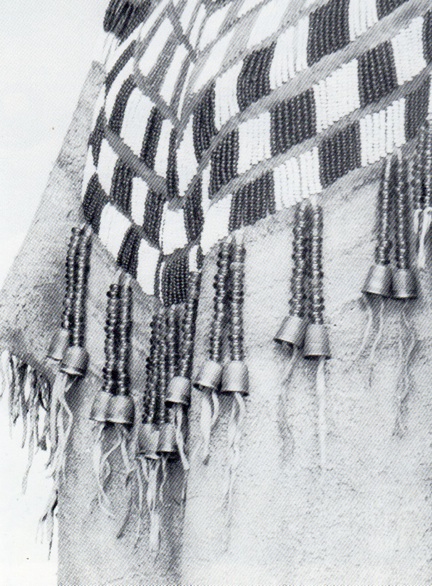
Plains buckskin dress decorated with brass thimbles ca. 1850
We have also seen a decoration made of feathers and a string of brass thimbles, again probably from a Plains tribe but the tribe and exact use is unknown. May be it was some form of tent decoration?
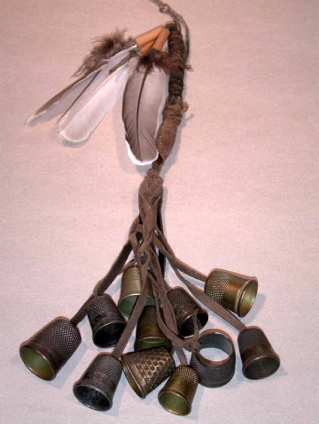
Tent/belt/fan decoration ca 1890
The ‘Indian trade’ of decorative items in the 18th and 19th century was not limited to thimbles, other silver ware items seem to have been traded and Indian trade bracelets from this period were popular and are well-published (Adam Brandow, Christie’s New York - personal communication). We were fascinated to find one such bracelet recently in a Christie’s catalogue. It was listed as a ‘George lll silver Indian trade bracelet’ bearing the mark of Hester Bateman, the leopard’s head crowned, the lion passant and the letter date for 1779.
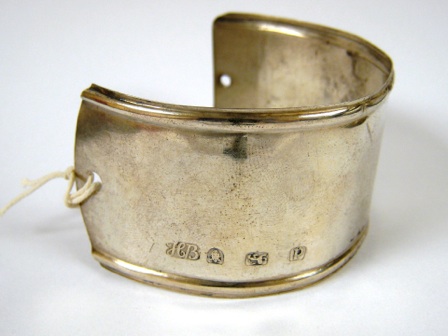
Trade bracelet
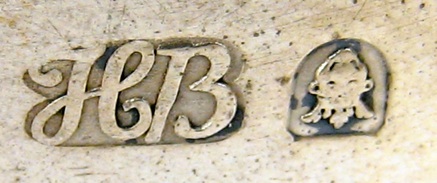
Hester Bateman mark
One of the most famous female English silversmiths, Hester Bateman, made thimbles in the 18th century; thimbles were traded with Native Americans for decorative purposes at the same time; other items of jewellery, including rings, beads and bracelets, were also traded; and one such traded silver bracelet was made by Hester Bateman, thus completing the circle ‘so to say’.
References (all websites accessed November 2011)
1. Inglis L. Hester Bateman: Illiterate Widow to Lady Tradesman. at:
http://www.georgianlondon.com/hester-bateman-illiterate-widow-to-lady-trade
2. Fur Trade at:
http://www.mpm.edu/wirp/ICW-146.html.
3. Expanding Trade: 1541 Coronado Reaches "Quivera". At:
4. Rendezvous Trade Goods. At:
http://www.xmission.com/~drudy/mtman/museum/goods/goods.html
5. Fur Trade. at:
http://en.wikipedia.org/wiki/Fur_trade
6. MacCauley C. The Seminole Indians of Florida, 1664. at:
http://www.nanations.com/seminole_indians_florida.htm
7. Cushman HB. History of Indians. 1899. cited by Holmes EF . A history of thimbles. London: Cornwall Books, 1985. pp. 244.3.
Holmes: ‘Thimbles for other uses’ pp. 234 and ‘Thimbles in England’ pp. 41.
Researched and published in 2002/11
Copyright@2011. All Rights Reserved
Magdalena and William Isbister, Moosbach, Germany
native americans, Hester bateman and thimbles
Navigation
